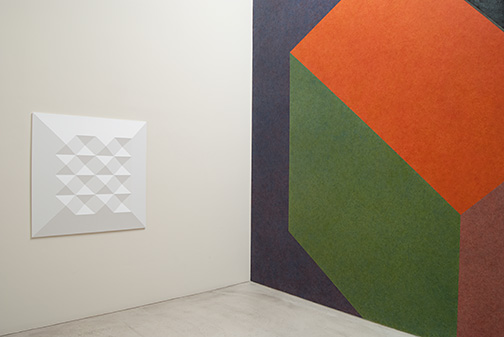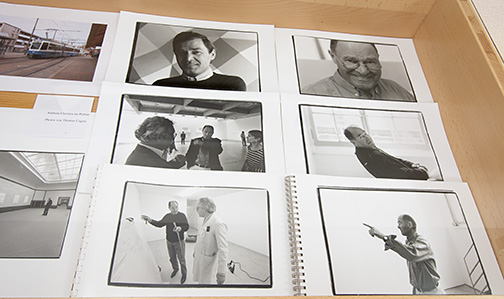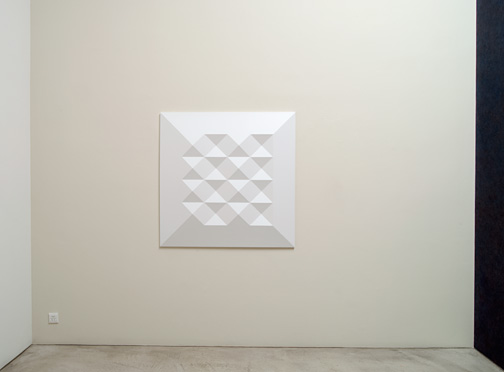Andreas Christen / Selected Works.
“Human lives are apparently just long enough that, when living for something, we are able to complete the trajectory from follower to predecessor and, in so doing, it matters less for human satisfaction what you are living for than the fact that you have anything to live for at all.” (Robert Musil from ‘The Man Without Qualities’)
Being artistically active close on the heels of a generation of artists whose program is assigned to a clear-cut term of art history is often a burden for the reception of an artist’s work. Andreas Christen (1936 – 2006) was invited by Max Bill to take part in his 1960 exhibition ‘konkrete kunst 50 jahre entwicklung’ (concrete art – 50 years of development) at Helmhaus Zurich. Helio Oiticica (1937 – 1980) and Andreas Christen figured as the youngest participants by far in the list of artists in this epochal show. It was an eminent gesture of esteem by an important personality in the art world who knew about setting international priorities. In addition, it merits recognition that Max Bill lent his proposed term of ‘concrete art’ to a clever and clear-sighted interpretation that still astounds us today. The artist list evinces no adherence to narrow and dogmatic aims, but rather an interest in bearing witness to the past and intimating the future. Yet despite the prevailing conviction that this or that artist is the pioneer of art’s continual development, seemingly at no time is it possible to make a truly accurate prediction. The continuity of art history is a construction that is created in retrospect. ‘Development’ does not proceed in a linear fashion. It is the result of a complex interlinking of countless artistic, social and societal factors and circumstances, and who would have thought at the time that the work as object would soon be called into question. The much-invoked aspect of innovation hence has to be understood differently. The fact that this had to yield today to the absolutization of the utterly new indicates the short-lived nature of such a criterion of consideration.
For the young Andreas Christen, the artistic context of ‘concrete art’ was understood as a link to modernist innovation, as a departure from local and provincial artistry and artistic activity. The works produced between 1957 and 1960, indebted to constructive art in formal terms, were sprayed with synthetic resin on industrially manufactured Masonite panels. The process of fabrication and the material hence mark a departure from traditional panel painting and from any sort of artistic signature. The process of disengaging from esteemed predecessors would continue to occupy Andreas Christen in the following years. It is a critical engagement with the achievements, axioms and paradigms of concrete and constructive art. The painting as an object demands more intrinsic value and reality; it becomes a relief. Playing with form and composition give way to a uniform structure of alternating elements. Spatiality, light and shadow formulate a living transformable occurrence resulting from the systematic and coherent sculptural treatment of the surface of the object in an interplay with its real environment. Lines are not illusionistic divisions of the plane, but actually existing factors of integral spatial and formal events through which a dissociation of individual parts in color is made obsolete.
The fact that after 1993 the pictorial object is no longer closed on four sides vis-à-vis the supporting wall, but is essentially superimposed on the supporting wall as a form assembled from inclined planes was understood by Andreas Christen as the valid solution he had previously only been able to approximate. His works are now an excerpt and part of a spatial continuum. They enable viewers to experience and reflect on their perception of light and space.
An initial show of works with Annemarie and Gianfranco Verna took place in 1981. For Andreas Christen, this meant a deliberate shift in the context for his artistic work. With the exhibition announced here, it now makes twelve solo presentations at the gallery along with numerous presentations as part of its group exhibitions and art fair shows.
Installation views

Installation view room 4

Installation view room 1

Installation view room 1

Installation view room 1

Installation view room 2

Installation view room 2

Installation view room 2

Installation view room 3

Installation view room 3

Installation view room 3

Installation view room 4

Installation view

Installation view

Installation view

Installation view
Works

Ohne Titel
2005
24 x 116 cm
MDF-Platte, weiss gespritzt

Sol LeWitt
Tilted Form with color ink washes superimposed
1987
Wall Drawing #524
Drawn by Nicolai Angelov

Monoform
1964
120 x 120 cm
Polyester, weiss gespritzt

Monoform
1964
120 x 120 cm
Polyester, weiss gespritzt

Komplementär-Struktur
1975
120 x 180 x 9 cm
Epoxy, weiss gespritzt

Komplementär-Struktur
1975
120 x 180 x 9 cm
Epoxy, weiss gespritzt

Komplementär-Struktur
1974
120 x 120 x 9 cm
Epoxy, weiss gespritzt

Komplementär-Struktur
1974
120 x 120 x 9 cm
Epoxy, weiss gespritzt

ohne Titel
1998
140 x 140 cm
MDF-Platte, weiss gespritzt

ohne Titel
1998
140 x 140 cm
MDF-Platte, weiss gespritzt

ohne Titel
1998
135 x 135 x 6.5 cm
MDF-Platte, weiss gespritzt

ohne Titel
1998
135 x 135 x 6.5 cm
MDF-Platte, weiss gespritzt

Ohne Titel
2005
160 x 160 cm
MDF-Platte, weiss gespritzt

Ohne Titel
2005
160 x 160 cm
MDF-Platte, weiss gespritzt

Untitled
2002
150 x 150 cm
MDF-Platte, weiss gespritzt

Untitled
2002
150 x 150 cm
MDF-Platte, weiss gespritzt
New
Exhibition
Dan Flavin (1933–1996) and Will Insley (1929–2011)
March 6 to April 26, 2024
New publications
James Bishop
James Bishop
Publisher: ER Publishing, Edited by Molly Warnock
Joseph Egan
Joseph Egan and Anton Himstedt: Common Ground
Publisher: Josef Albers Museum Quadrat Bottrop, Ulrike Growe
Exhibitions / Insight
INSIGHT #3 spotlights the graphic work of Fred Sandback through three examples from 1974 and 1982.
Joseph Egan, Ptolemäus: Die Welt im Griff? Antike Kartographie und zeitgenössische Kunst, Kunsthaus Grenchen
3. März bis 26. Mai 2024
Dan Flavin, Widmungen aus Licht, Kunstmuseum Basel
2. März bis 18. August 2024
Rita McBride, Momentum,
Dia Beacon, Beacon, NY,
July 1, 2023 to January 2025
Fred Sandback, Kurt Büsser ermöglicht... Erich Buchholz und Fred Sandback, Museum Wiesbaden
19. Januar bis 14. April 2024
Sol LeWitt (1928–2007)
A Wall Drawing Retrospective
Yale University Art Gallery and Williams College Museum of Art
November 16, 2008 – 2033

